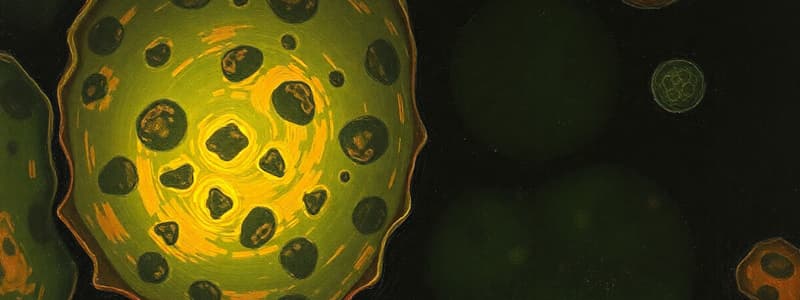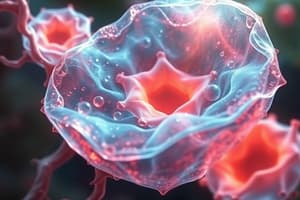Podcast
Questions and Answers
What is the primary function of the long, thin structures attached to bacteria?
What is the primary function of the long, thin structures attached to bacteria?
- To protect against disease.
- To generate energy.
- To facilitate movement. (correct)
- To store nutrients.
Which type of bacterium is Lactobacillus?
Which type of bacterium is Lactobacillus?
- Spherical.
- Cylindrical (rod-shaped). (correct)
- Spiral.
- Irregular in shape.
Which cell structure is responsible for energy production in eukaryotic cells?
Which cell structure is responsible for energy production in eukaryotic cells?
- Ribosomes.
- Endoplasmic Reticulum.
- Nucleus.
- Mitochondria. (correct)
What characterizes Rough Endoplasmic Reticulum (R.E.R.)?
What characterizes Rough Endoplasmic Reticulum (R.E.R.)?
Why do cells need to divide in the body?
Why do cells need to divide in the body?
What do animal cells use for carbohydrate storage?
What do animal cells use for carbohydrate storage?
Which structure in a plant cell is responsible for photosynthesis?
Which structure in a plant cell is responsible for photosynthesis?
Which of the following components do bacteria cells lack?
Which of the following components do bacteria cells lack?
What is the primary function of the cell membrane in both plant and animal cells?
What is the primary function of the cell membrane in both plant and animal cells?
What component gives plant cells their shape and support?
What component gives plant cells their shape and support?
Which statement about ribosomes is true?
Which statement about ribosomes is true?
What is one unique characteristic of bacterial cells compared to plant and animal cells?
What is one unique characteristic of bacterial cells compared to plant and animal cells?
Which carbohydrate do plant cells primarily use for storage?
Which carbohydrate do plant cells primarily use for storage?
Which part of the cell does aerobic respiration primarily occur?
Which part of the cell does aerobic respiration primarily occur?
What is the primary function of the permanent vacuole in plant cells?
What is the primary function of the permanent vacuole in plant cells?
What is the primary function of red blood cells?
What is the primary function of red blood cells?
Which adaptation of ciliated cells aids in their function?
Which adaptation of ciliated cells aids in their function?
What process allows cells to develop specialized characteristics?
What process allows cells to develop specialized characteristics?
Why do sperm cells have a mid-piece filled with mitochondria?
Why do sperm cells have a mid-piece filled with mitochondria?
What is the function of xylem vessels in plants?
What is the function of xylem vessels in plants?
What is the characteristic structure of palisade mesophyll cells?
What is the characteristic structure of palisade mesophyll cells?
What is the role of haemoglobin in red blood cells?
What is the role of haemoglobin in red blood cells?
What happens to the cell membrane of an egg cell after fertilization?
What happens to the cell membrane of an egg cell after fertilization?
The main purpose of root hair cells is to:
The main purpose of root hair cells is to:
In the magnification formula, what does the image size relate to?
In the magnification formula, what does the image size relate to?
What type of cell structure is designed to lack organelles to assist in water passage?
What type of cell structure is designed to lack organelles to assist in water passage?
What is the primary adaptation of the nerve cell for conducting impulses?
What is the primary adaptation of the nerve cell for conducting impulses?
Which structure in the sperm cell is responsible for penetrating the egg?
Which structure in the sperm cell is responsible for penetrating the egg?
What type of tissue is commonly found in the digestive system?
What type of tissue is commonly found in the digestive system?
Flashcards
Ribosomes
Ribosomes
The site of protein synthesis in cells.
Cytoplasm
Cytoplasm
A gel-like substance that fills the cell, supporting internal structures and serving as the location for many chemical reactions.
Cell membrane
Cell membrane
The membrane that encloses a cell, controlling the passage of substances in and out.
Mitochondria
Mitochondria
Signup and view all the flashcards
Nucleus
Nucleus
Signup and view all the flashcards
Cell wall
Cell wall
Signup and view all the flashcards
Chloroplasts
Chloroplasts
Signup and view all the flashcards
Permanent vacuole
Permanent vacuole
Signup and view all the flashcards
Bacteria
Bacteria
Signup and view all the flashcards
Plasmids
Plasmids
Signup and view all the flashcards
Flagella
Flagella
Signup and view all the flashcards
Rough Endoplasmic Reticulum (RER)
Rough Endoplasmic Reticulum (RER)
Signup and view all the flashcards
Vesicles
Vesicles
Signup and view all the flashcards
Cell differentiation
Cell differentiation
Signup and view all the flashcards
Diffusion
Diffusion
Signup and view all the flashcards
Cilia
Cilia
Signup and view all the flashcards
Axons
Axons
Signup and view all the flashcards
Myelin sheath
Myelin sheath
Signup and view all the flashcards
Red blood cell function
Red blood cell function
Signup and view all the flashcards
Sperm cell head
Sperm cell head
Signup and view all the flashcards
Sperm cell mid-piece
Sperm cell mid-piece
Signup and view all the flashcards
Root hair cell function
Root hair cell function
Signup and view all the flashcards
Xylem vessel function
Xylem vessel function
Signup and view all the flashcards
Palisade mesophyll cell function
Palisade mesophyll cell function
Signup and view all the flashcards
Tissue
Tissue
Signup and view all the flashcards
Organ
Organ
Signup and view all the flashcards
Organ system
Organ system
Signup and view all the flashcards
Magnification formula
Magnification formula
Signup and view all the flashcards
Study Notes
Animal Cell Structure
- Animal cells have a nucleus with a distinct membrane
- Animal cells lack cellulose cell walls
- Animal cells lack chloroplasts, therefore, cannot perform photosynthesis
- Animal cells store carbohydrates as glycogen
Plant Cell Structure
- Plant cells have a nucleus with a distinct membrane
- Plant cells have cell walls made of cellulose
- Plant cells contain chloroplasts, enabling photosynthesis
- Plant cells store carbohydrates as starch or sucrose
Plant and Animal Cell Structure and Function
Nucleus
- Contains DNA (genetic material) controlling cell activities
Cytoplasm
- Gel-like substance containing water and dissolved substances
- Supports internal structures
- Site of many chemical reactions
Cell Membrane
- Separates the inside of the cell from the outside
- Controls which substances enter and leave the cell
- Site of protein synthesis
- Site of anaerobic respiration
Ribosomes
- Found in the cytoplasm
- The site of protein synthesis
Mitochondria
- The site of aerobic respiration
Studying That Suits You
Use AI to generate personalized quizzes and flashcards to suit your learning preferences.




